instrument panel AUDI A8 2013 User Guide
[x] Cancel search | Manufacturer: AUDI, Model Year: 2013, Model line: A8, Model: AUDI A8 2013Pages: 318, PDF Size: 79.34 MB
Page 158 of 318
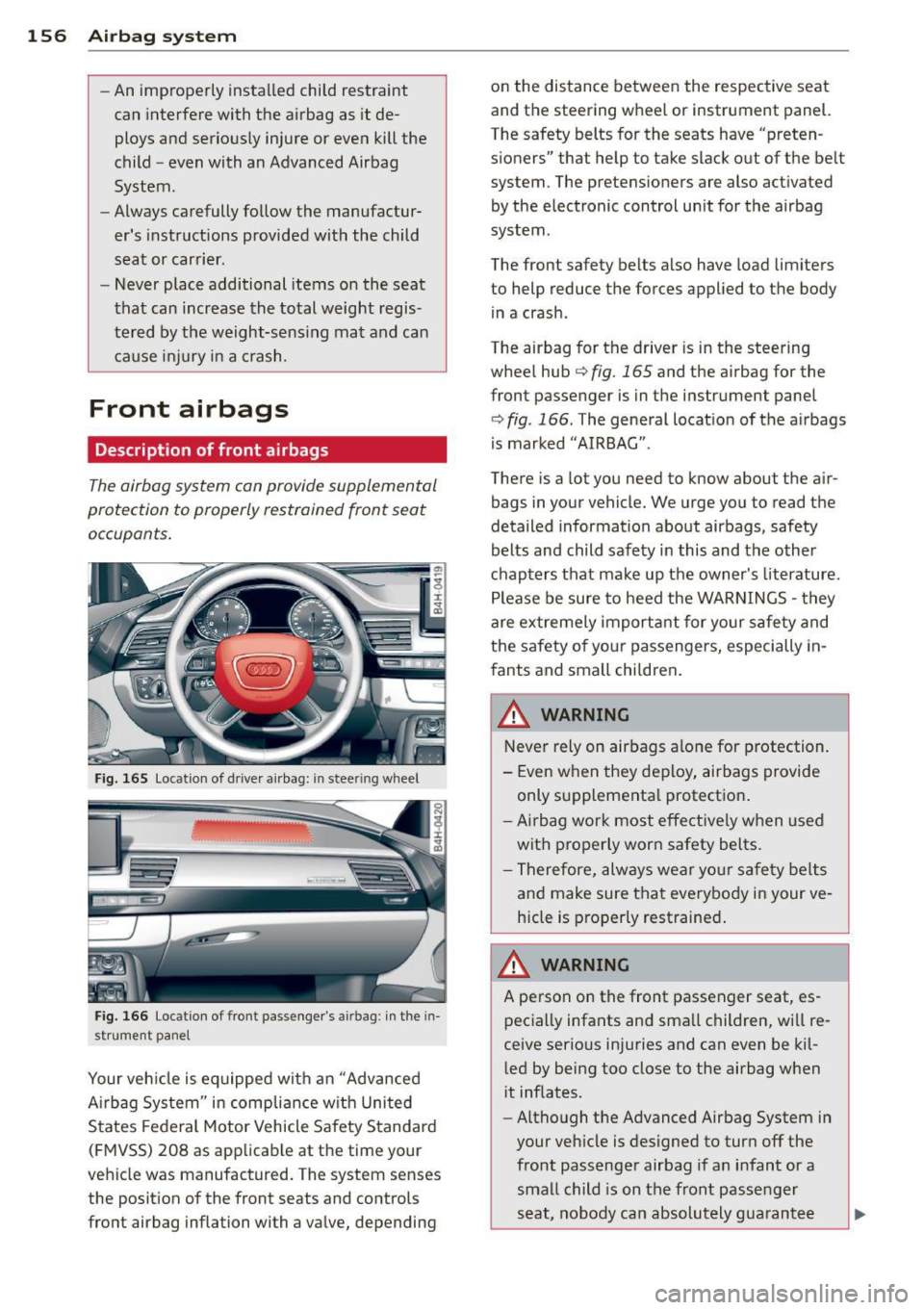
156 Airbag system
-An improperly installed child restraint
can interfere with the airbag as it de
ploys and seriously injure or even kill the
child -even with an Advanced Airbag
System .
- Always carefully follow the manufactur
er's instructions provided with the child
seat or carrier .
- Never place additional items on the seat
that can increase the total weight regis tered by the weight-sensing mat and can
cause injury in a crash .
Front airbags
Description of front airbags
The airbag system con provide supplemental
protect ion to properly restrained front seat
occupants.
Fig. 165 Location of dr iver airbag: in stee ring wheel
Fig. 166 Locat ion of front passenger's airb ag: in the in
s trument panel
Your vehicle is equipped with an "Advanced
A irbag System" in compliance w ith United
States Federal Motor Vehicle Safety Standard
(FMVSS) 208 as applicable at the time you r
vehicle was manufactured. The system senses
the position of the front seats and controls
front airbag inflation with a valve, depending on
the distance between the respective seat
and the steering wheel or instrument panel.
The safety belts for the seats have "preten sioners" that help to take slack out of the belt
system. The pretensioners are also activated by the electronic control unit for the airbag
system.
The front safety belts also have load limiters
to help reduce the forces applied to the body in a crash .
The airbag for the driver is in the steering
wheel hub
¢fig. 165 and the airbag for the
front passenge r is in the instrument panel
¢ fig . 166 . The general location of the airbags
is marked "AIRBAG".
There is a lot you need to know about the air
bags in your vehicle. We urge you to read the
detailed information about airbags, safety
belts and child safety in this and the other
chapters that make up the owner's literature .
Please be sure to heed the WARNINGS -they
are extremely important for your safety and
the safety of you r passengers, especially in
fants and small children.
A WARNING
Never rely on airbags alone for protection.
- Even when they deploy, airbags provide
only supplementa l protection .
-Airbag work most effective ly when used
with properly worn safety belts.
- Therefore, always wear your safety belts
and make sure that everybody in your ve
hicle is properly restrained .
A WARNING
A person on the front passenger seat , es
pecially infants and sma ll children, will re
ceive serious injuries and can even be kil
led by being too close to the airbag when
it inflates .
- Although the Advanced Airbag System in
your vehicle is designed to turn off the
front passenger airbag if an infant or a
small child is on the front passenger
seat, nobody can absolutely guarantee ..,.
Page 159 of 318
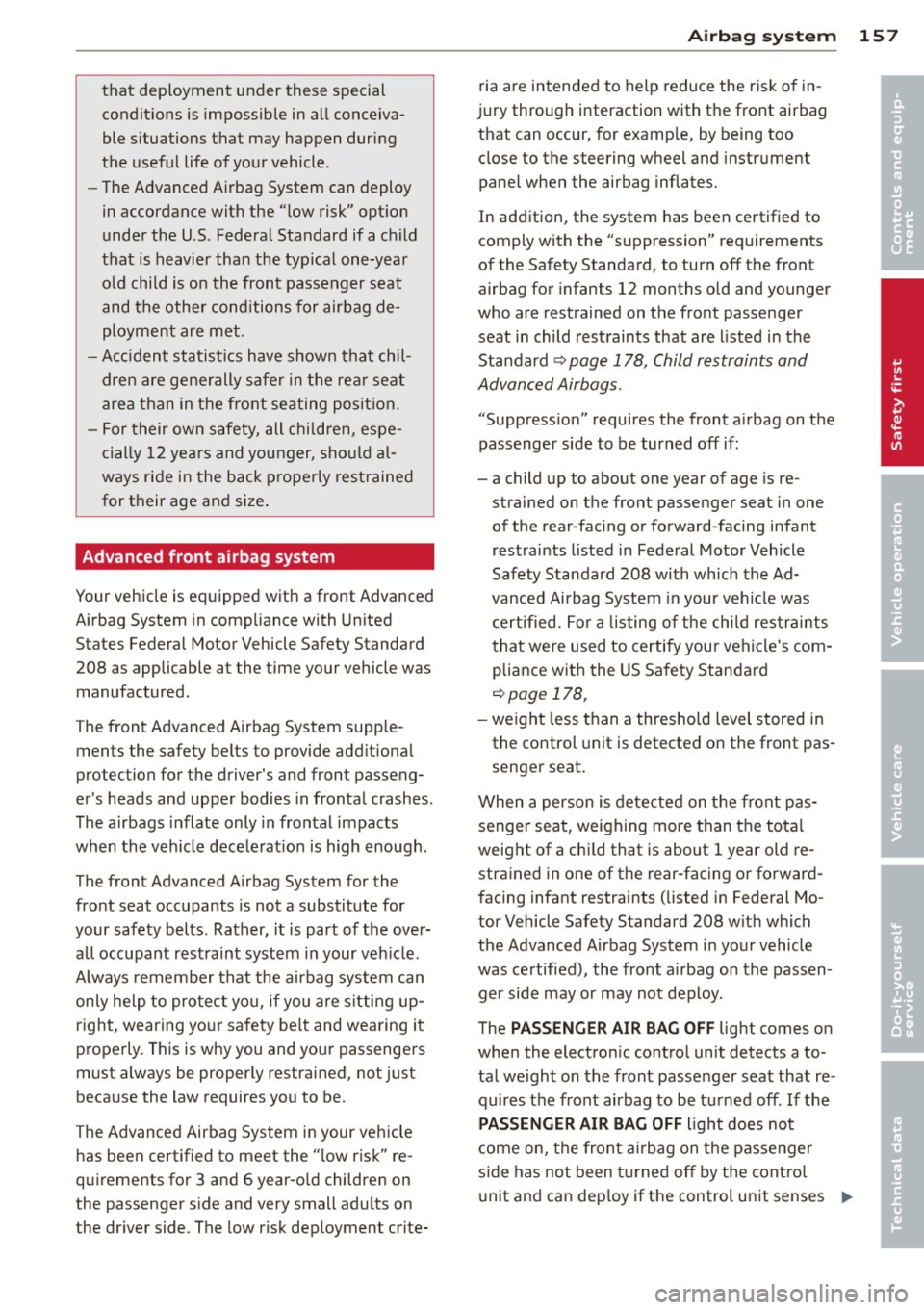
that deployment under these special
conditions is impossible in all conceiva
ble situations that may happen during
the useful life of your vehicle .
- The Advanced Airbag System can deploy
in accordance with the "low risk" option
under the U .S . Federal Standard if a child
that is heavier than the typical one-year old child is on the front passenger seat
and the other conditions for airbag de
ployment are met .
- Accident statistics have shown that chil
dren are generally safer in the rear seat
area than in the front seating position.
- For their own safety, all children, espe
cially 12 years and younger, should al
ways ride in the back properly restrained
for their age and size.
Advanced front airbag system
Your vehicle is equipped with a front Advanced
Airbag System in compliance with United
States Federal Motor Vehicle Safety Standard
208 as applicable at the time your vehicle was
manufactured .
T he front Advanced Airbag System supple
ments the safety belts to provide additional
protection for the driver's and front passeng
er's heads and upper bodies in frontal crashes .
The airbags inflate only in frontal impacts
when the vehicle deceleration is high enough.
The front Advanced Airbag System for the
front seat occupants is not a substitute for
your safety belts . Rather, it is part of the over
all occupant restraint system in your vehicle .
Always remember that the airbag system can
only help to protect you, if you are sitting up
right , wearing your safety belt and wearing it
properly. This is why you and your passengers
must always be properly restrained , not just
because the law requires you to be.
The Advanced Airbag System in your vehicle has been certified to meet the "low risk" re
quirements for 3 and 6 year-old children on
the passenger side and very small adults on
the driver side. The low risk deployment crite-
Airbag system 157
ria are intended to help reduce the risk of in
jury through interaction with the front airbag that can occur, for example, by being too
close to the steering wheel and instrument
panel when the airbag inflates.
In addition, the system has been certified to
comply with the "suppression" requirements
of the Safety Standard, to turn off the front
airbag for infants 12 months old and younger
who are restrained on the front passenger
seat in child restraints that are listed in the
Standard
¢ page 178, Child restraints and
Advanced Airbags.
"Suppression" requires the front airbag on the
passenger side to be turned off if:
- a child up to about one year of age is re
strained on the front passenger seat in one
of the rear -facing or forward-facing infant
restraints listed in Federal Motor Vehicle
Safety Standard 208 with which the Ad
vanced Airbag System in your vehicle was
certified . For a listing of the child restraints
that were used to certify your vehicle's com
pliance with the US Safety Standard
¢page 178,
-weight less than a threshold level stored in
the control unit is detected on the front pas
senger seat.
When a person is detected on the front pas
senger seat, weighing more than the total
weight of a child that is about 1 year old re
strained in one of the rear-facing or forward
facing infant restraints (listed in Federal Mo
tor Vehicle Safety Standard 208 with which
the Advanced Airbag System in your vehicle
was certified), the front airbag on the passen
ger side may or may not deploy.
The
PASSENGER AIR BAG OFF light comes on
when the electronic control unit detects a to
tal weight on the front passenger seat that re
quires the front airbag to be turned off. If the
PASSENGER AIR BAG OFF light does not
come on, the front airbag on the passenger
side has not been turned off by the control
unit and can deploy if the control unit senses
11-
•
•
Page 160 of 318
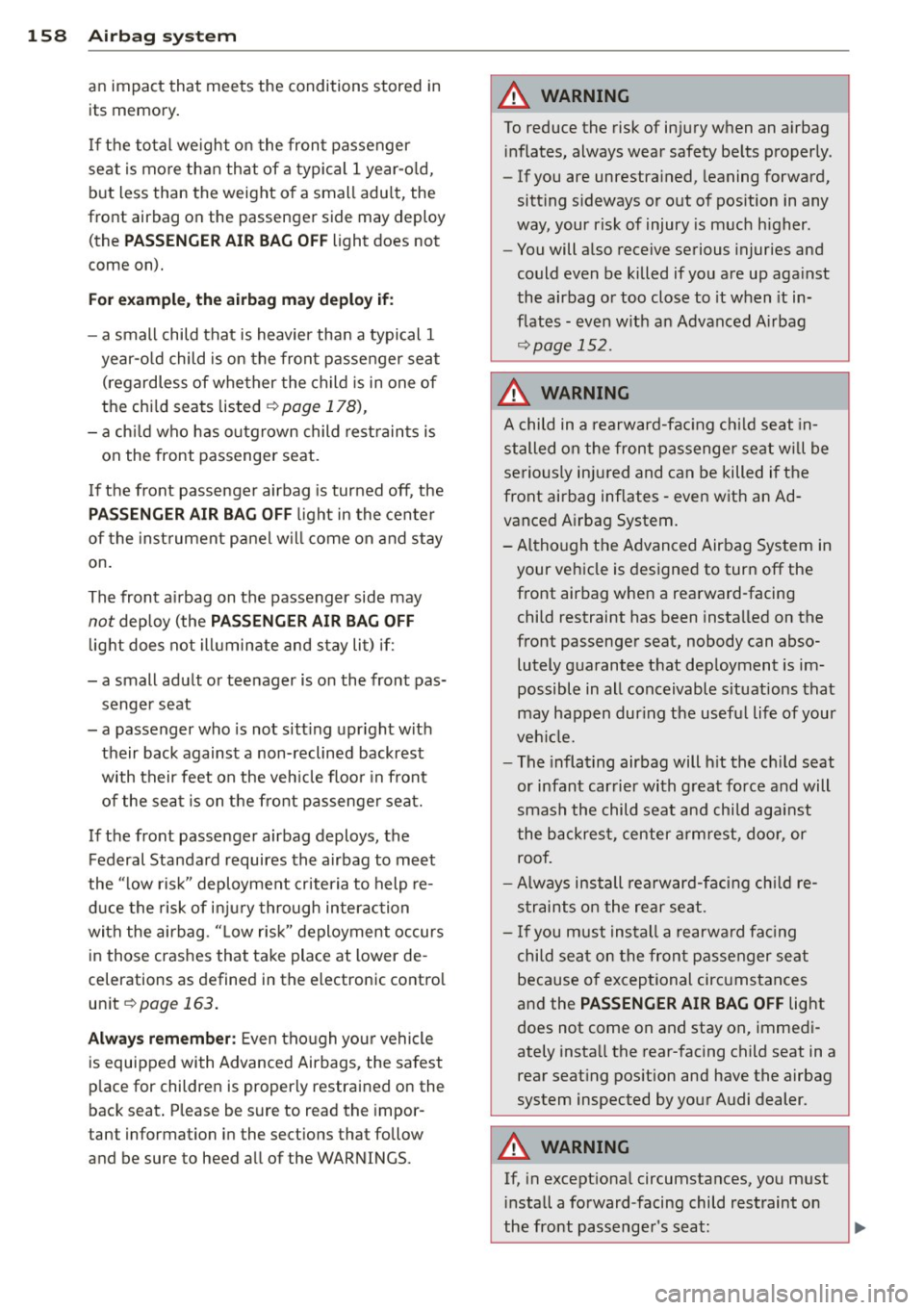
158 Airb ag sys te m
an impact that meets the conditions stored in
its memory .
I f the total weight on the front passenger
seat is more than that of a typical 1 year-o ld,
but less than the weight of a small adu lt, the
front airbag on the passenger side may deploy (the
PASSENGER AIR B AG OFF light does not
come on).
For exa mple , the airbag ma y depl oy if :
- a small child that is heavier than a typical 1
year-o ld child is on the front passenger seat
(regardless of whe ther the child is in one of
the chi ld seats listed
¢ page 178),
- a ch ild who has outgrown child rest raints is
on the front passenger seat.
If the front passenger airbag is turned off, the
PA SSENGER AIR BAG OFF light in the cente r
of the instrument panel w ill come on and stay
on.
The front a irbag on the passenger side may
not deploy (the PAS SENGER AIR BAG OFF
light does not illuminate and stay lit) if:
- a small adult or teenager is on the front pas
senger seat
- a passenger who is not sitt ing upright wit h
their back against a non-reclined backrest
with their feet on the veh icle floo r in front
of the seat is on the front passenger seat.
If the front passenger airbag deploys, the Federal Standard requires the a irbag to meet
the "low risk" deployment criteria to help re
d uce the risk of inju ry through interaction
with the airbag. " Low risk" deployment occurs
in those crashes that take place at lower de
celerations as defined in the electronic control un it
¢ page 163.
Alw ays re memb er: Even tho ugh you r vehicle
is equipped with Advanced Airbags, the safest
p lace for children is properly restrained on the
back seat . Please be sure to read the impor
tant information in the sect ions that follow
and be sure to heed all of the WARNINGS.
A WARNING
To reduce the risk of injury when an a irbag
i nflates, always wear safety be lts properly.
- If you are unrestra ined, leaning forward,
sitt ing s ideways or out of pos ition in any
way, your risk of injury is much h igher.
- You will a lso receive serious injuries and
could even be killed if you are up aga inst
the airbag or too close to it when it in
flates -even w ith an Advanced A irbag
¢ page 152.
A WARNING
A child in a rearward-fac ing ch ild seat in
stalled on the front passenger se at will be
se riously injured and can be killed if the
front airbag inflates -even with an Ad
vanced Airbag System.
- Altho ugh the Advanced Airbag System in
your vehicle is designed to turn off the
front airbag when a rearward-facing
child restraint has been installed on the
front passenger seat, nobody can abso
lutely guarantee that dep loyment is im
possible in all conceivable situations that
may happen dur ing the usefu l life of your
veh icle.
- The inflating airbag will h it the ch ild seat
or infant car rier with g reat force and will
smash the child seat and child against
the backrest, center armrest, door, or
roof.
- Always install rearward-facing ch ild re
s traints on the rear seat.
- I f you must ins tall a rearward fac ing
child seat on the fron t passenger seat
because of exceptional circumstances
and the
PASSENGER AIR BAG OFF light
does not come on and stay on, immedi
ately insta ll the rear-facing child seat in a
rear seat ing pos ition and have the airbag
system inspected by your Audi dealer.
A WARNING
If, in exceptional circumstances, you must
i nstall a forward-facing child restraint on
the front passenger's seat:
-
Page 161 of 318
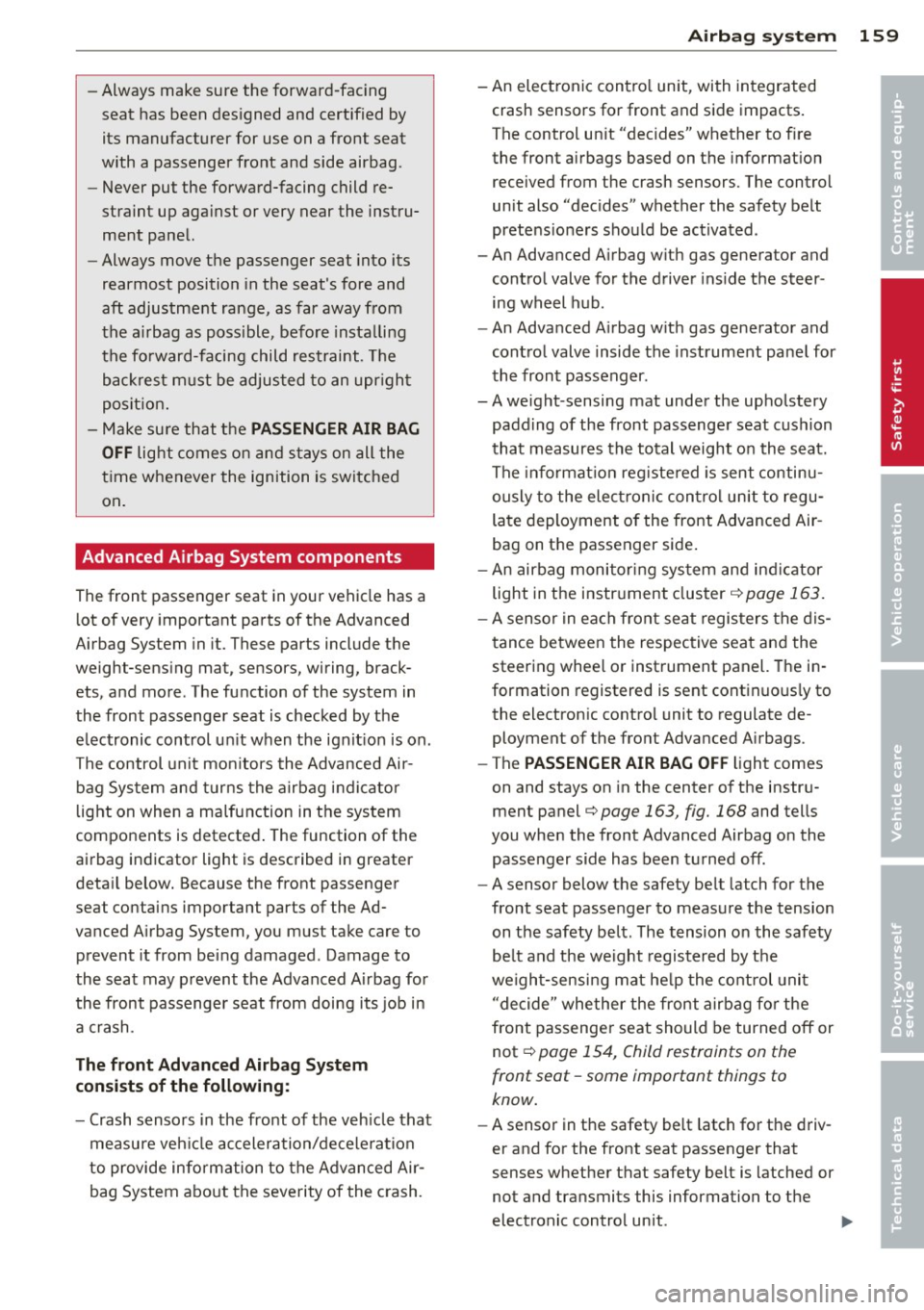
-Always make sure the forward-facing
seat has been des igned and certified by
its manufacturer for use on a front seat
with a passenger front and side airbag.
- Never put the forward-facing child re
straint up aga inst or very near the instru
ment panel.
- Always move the passenger seat into its
rearmost position in the seat's fore and
aft adjustment range, as far away from
the a irbag as poss ible, before insta lling
the fo rward -facing child restraint. T he
b ackres t m ust be adjus ted to an upr igh t
posit ion.
- Make su re that the
PASSENGER AIR BAG
OFF
light comes on and s tays on all the
t ime whenever the ignition is switched
on .
Advanced Airbag System components
The front passenger seat in your vehicle has a
l ot of very important parts of the Advanced
Airbag System in it. These parts include the
weight-sens ing mat, sensors, wiring, brack
ets, and more . The function of the system in
the front passenger seat is checked by the
e lectronic control un it when the ign it ion is on .
The control un it mon itors the Advance d Air
bag Sys tem and turn s the a irbag i ndica tor
light on when a ma lfunction in t he system
compo nents is detected . The function of the
ai rbag indicator light is described in greater
deta il below. Because the front passenger
seat contains important parts of the Ad
va nced A irbag System, you must take care to
prevent it from being damaged . Damage to
the seat may p revent the Advanced A irbag for
the front passenger seat from doing its job in
a crash .
The front Advanced Airb ag System
consists of the following:
- Crash senso rs in the front of the veh icle that
measu re ve hicle accelera tion/decele ra ti on
to provide info rm ation to the Advanced Air
bag System abo ut the severity of the crash.
A irbag system 159
-An elect ron ic cont ro l unit, with integrated
crash sensors for front and side impacts .
The control un it "decides" whether to f ire
the front a irbags based on the informat ion
received from the crash sensors. The control
unit also "decides" whether the safety belt
prete nsione rs shou ld be act iva ted.
- An Advanced A irbag w it h gas generator and
cont ro l valve for the d river ins ide the steer
ing wheel h ub.
- An Advanced A irbag w ith gas generator and
cont ro l valve inside the instrument pa ne l for
the front passenger .
- A weight -sensing mat unde r the upho lstery
padding of the front passenge r seat cushion
that measures the to tal weight o n the seat.
The info rmat ion reg iste red is sent continu
ously to the elect ronic con trol u nit to regu
la te deployment of the front Advanced Air
bag on the passenger side .
- An airbag moni tor ing sys tem and ind icator
light in the instr ument cluster
¢ page 163.
-A sen sor in each fron t seat regis ters the dis
t ance betwee n the respec tive seat and the
steering whee l or instrument panel. The i n
formation registered is sent cont inuo usly to
the electron ic contro l unit to regulate de
ployment of the front Advanced A irbags .
- The
PASSENGER AIR BAG OFF light comes
on and stays on in the center o f the instr u
ment panel¢
page 163, fig. 168 and tells
you whe n the front Advanced Airbag on the
passe nger side has been tu rned off.
- A sensor below the safety belt latch for the
front seat passenger to measure t he tension
on the safety belt. The tension o n the safety
be lt and the weight regis tered by the
weigh t-sensi ng mat he lp the cont rol uni t
"de cide" whe ther the front airbag fo r the
front passenge r seat should be turned off or
not
~ page 154, Child restraints on the
front seat -some important things to
know.
- A sensor in t he safety be lt latch fo r the d riv
er and for the front seat passenger that
senses w hethe r th at safety belt is latched or
not and transmits this information to the
electronic control unit.
•
•
Page 162 of 318
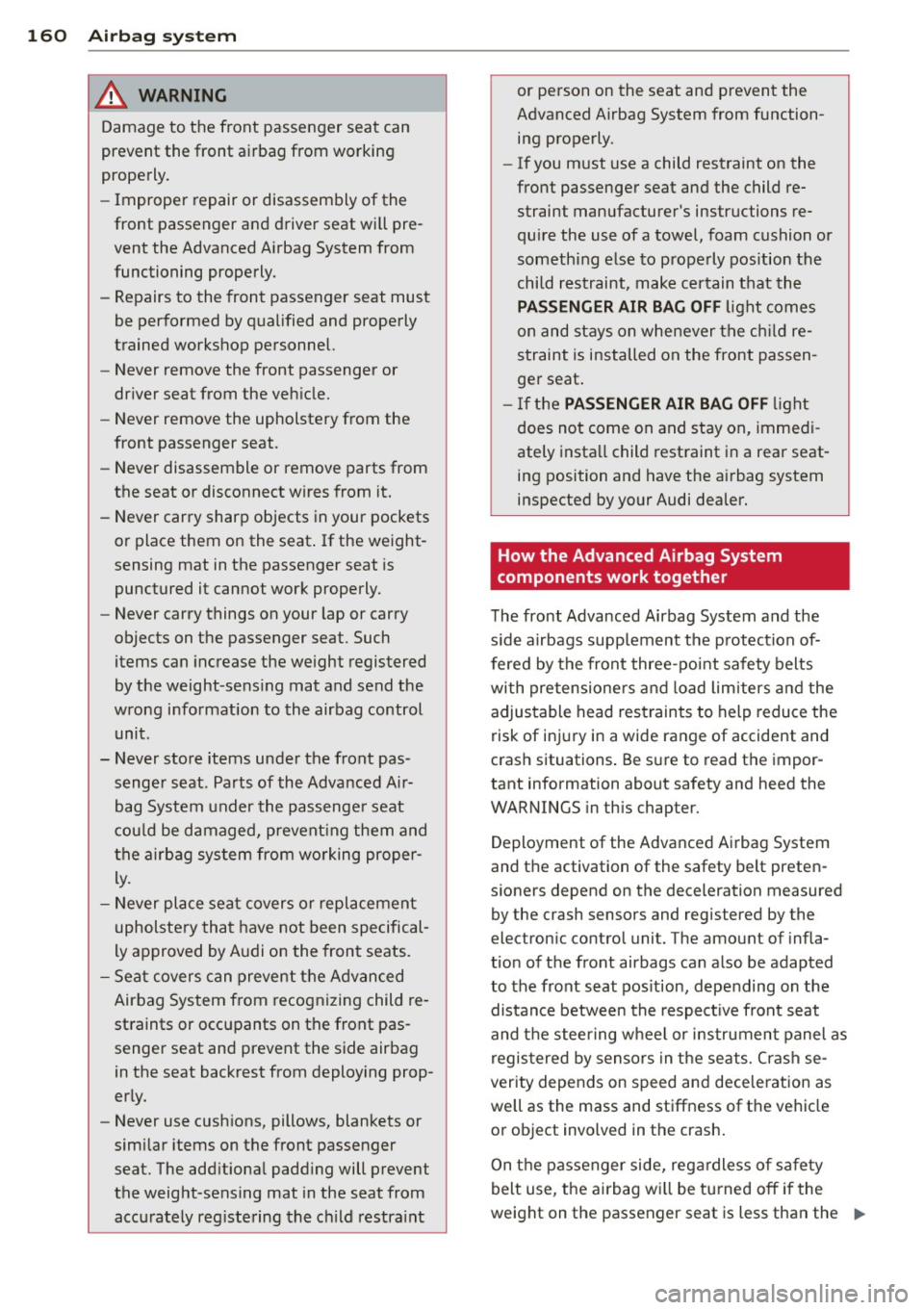
160 Airbag sys te m
_& WARNING
Damage to the front passenger seat can
prevent the front airbag from working
properly.
- Improper repair or disassembly of the
front passenger and driver seat wi ll pre
vent the Advanced A irbag System from
functioning properly.
- Repairs to the front passenger seat must
be performed by q ualified and properly
trained workshop personnel.
- Never remove the front passenger or
dr iver seat from the veh icle.
- Never remove the upholstery from the
front passenger seat.
- Never disassemble or remove parts from
the seat or disconnect wires from it.
- Never carry sharp objects in your pockets
or place them on the seat . If the weight
sensing mat in the passenger seat is
punctured it cannot work properly.
- Never carry things on your lap or carry
objects on the passenger seat. Such
items can increase the weight registered
by the weight-se nsing mat and send the
wrong info rmation to the airbag control
unit.
- Never store items under the front pas senger seat. Parts of the Advanced Ai r
bag System under the passenge r seat
c ou ld be damaged, prevent ing them and
the a irbag sys tem from working proper
ly .
- N ever place sea t covers or replacement
upholstery that have not been specifical
ly approved by A udi on the fron t seats.
- Seat covers can preven t th e Advanced
Airbag System from recognizing child re
st raints or occupants on the front pas
senger seat and prevent the side airbag
in the seat backrest from deploy ing prop
er ly.
- Never use cushions, pillows, blankets or
similar items on the front passenger seat. The add itiona l padd ing will prevent
the weight-sensing mat in the seat from
accu rately reg iste ring the c hild restra int
-
or person on the seat and prevent the
Advanced Airbag System from function
ing p roperly.
- If you must use a child restraint on the
front passenger seat and the child re
straint manufacturer's instructions re
qu ire the use of a towel, foam cushion or
something e lse to prope rly pos ition the
child restraint, make certain t hat the
PASSENGER AIR BAG OFF lig ht comes
on and stays on whenever the ch ild re
straint is installed on the front passen
ge r seat .
- If the PASSENGER AIR BAG OFF light
does not come on and stay on, immedi
ately insta ll child restraint in a rear seat
ing position and have the ai rbag system
inspected by your Audi dea ler.
How the Advanced Airbag System
components work together
T he front Advanced Airbag System and the
s ide a irbags supp lem ent the p rotection of
fered by the front three-po int safety belts
with pre tensione rs and load lim iters and the
adjustable head res train ts to help redu ce the
risk of in jury in a wide ra nge of accident and
crash situations . Be s ure to read the impor
tant information about safety and heed the
WARNINGS in th is chapter.
Deployment of the Adv a need Airbag System
and t he activation of the safety belt preten
s ioners depend on the deceleration measured
by the crash sensors and registered by the
electron ic co ntrol unit. The amount of infla
t ion of t he front airbags can a lso be adapted
to the front seat pos ition, depending on the
distance between the respective front seat
and t he steer ing w heel or instrument panel as
regis tered by sensors in the seats. C rash se
verity depends on speed and dece leration as
well as the mass and st iffness of t he vehicle
or object involved in the crash .
On t he passenger side, rega rdless of sa fe ty
belt use, the airbag w ill be turned off if the
weight on the passenger seat is less than the ..,.
Page 165 of 318
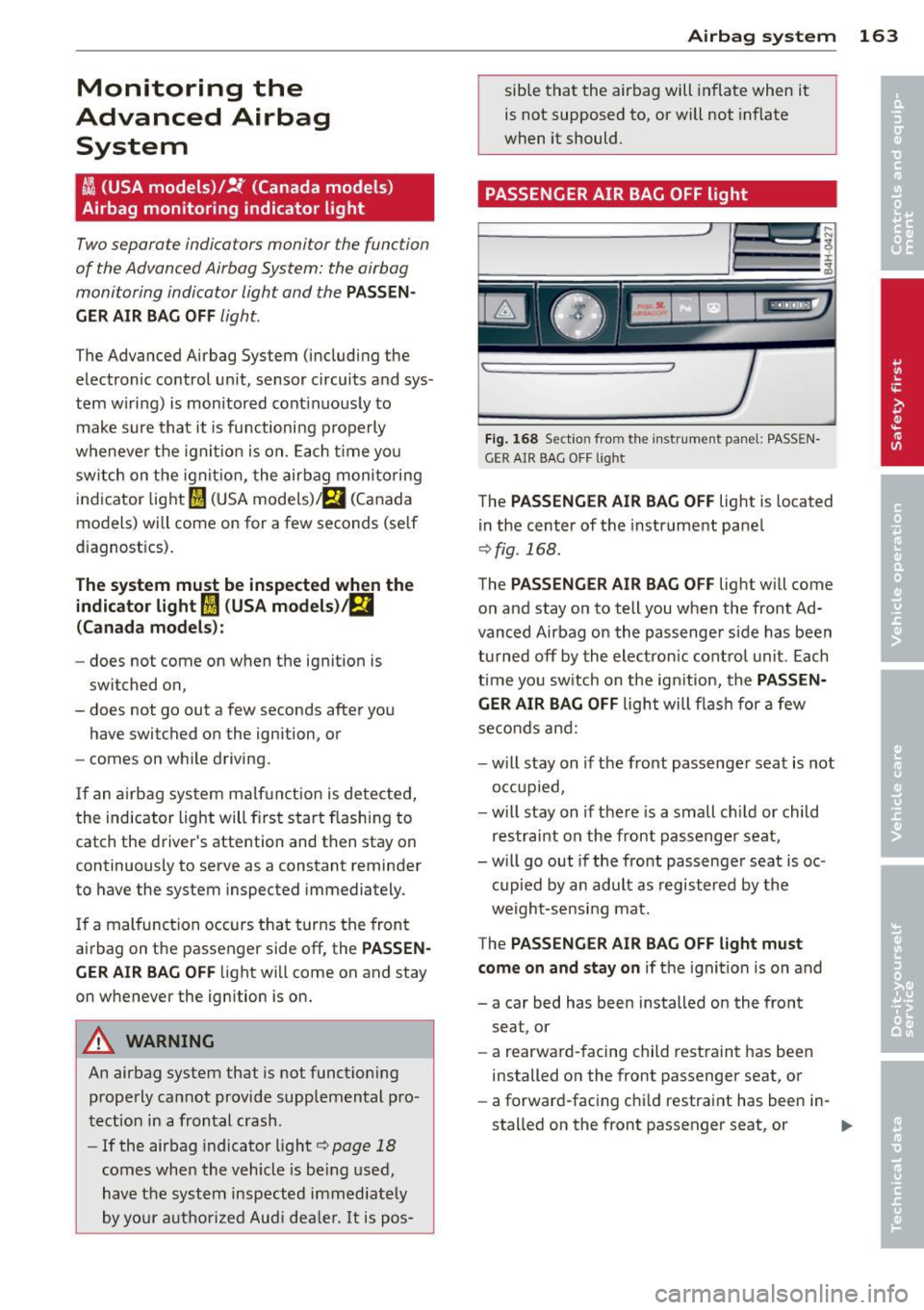
Monitoring the
Advanced Airbag
System
I ( USA models) /!{ (Canada models )
Airbag monitoring indicator light
Two separate indicators monitor the function
of the Advanced Airbag System: the airbag
monitoring indicator light and the
PASSEN
GER AIR BAG OFF
light.
The Advanced Airbag System (including the
electronic control un it, sensor circuits and sys
tem wiring) is monitored continuously to
make sure that it is functioning properly
whenever the ignit ion is on. Each time you
switch on the ignition, the airbag monitoring
indicator light
I (USA models)/ m (Canada
models) will come on for a few seconds (self
diagnost ics).
The system must be inspected when the
indicator light
I (USA models)/fll
(Canada models):
-does not come on when the ignition is
switched on ,
- does not go out a few seconds after you
have switched on the ignition, or
- comes on while driving.
If an airbag system malfun ction is detected,
the indicator light will first start flashing to
catch the driver's attention and then stay on
continuously to serve as a constant reminder
to have the system inspected immediately.
If a malfunction occurs that turns the front
airbag on the passenger side
off, the PASSEN
GER AIR BAG OFF
light will come on and stay
on whenever the ignition is on.
A WARNING
An airbag system that is not funct ioning
properly cannot provide supplemental pro
tection in a frontal crash.
- If the airbag indicator light
c:> page 18
comes when the vehicle is be ing used,
have the system inspected imm ediately
by your autho rized Audi dealer.
It is pos-
Airbag system 163
sible that the airbag will inflate when it
is not supposed to, or will not inflate
when it should.
PASSENGER AIR BAG OFF light
Fig. 168 Sect io n from the instrument pane l: PASSEN·
GER AIR BAG OFF light
The PASSENGER AIR BAG OFF light is located
in the center of the instrument panel
c:>fig . 168.
The PASSENGER AIR BAG OFF light will come
on and stay on to tell you when the front Ad
vanced Airbag on the passenger s ide has been
turned
off by the electron ic control unit. Each
time you switch on the ignition, the
PASSEN
GER AIR BAG OFF
light will flash for a few
seconds and:
- will stay on if the front passenger seat is not
occupied,
- will stay on if there is a small ch ild or child
restraint on the front passenger seat,
- w ill go out if the front passenger seat is oc·
cupied by an adult as registered by the
weight-sensing mat.
The
PASSENGER AIR BAG OFF l ight must
come on and stay on
if the ignition is on and
- a car bed has been installed on the front seat, or
- a rearward-facing child restraint has been
installed on the front passenger seat, or
- a forward-facing child restraint has been in·
stalled on the front passenger seat, or
Page 167 of 318
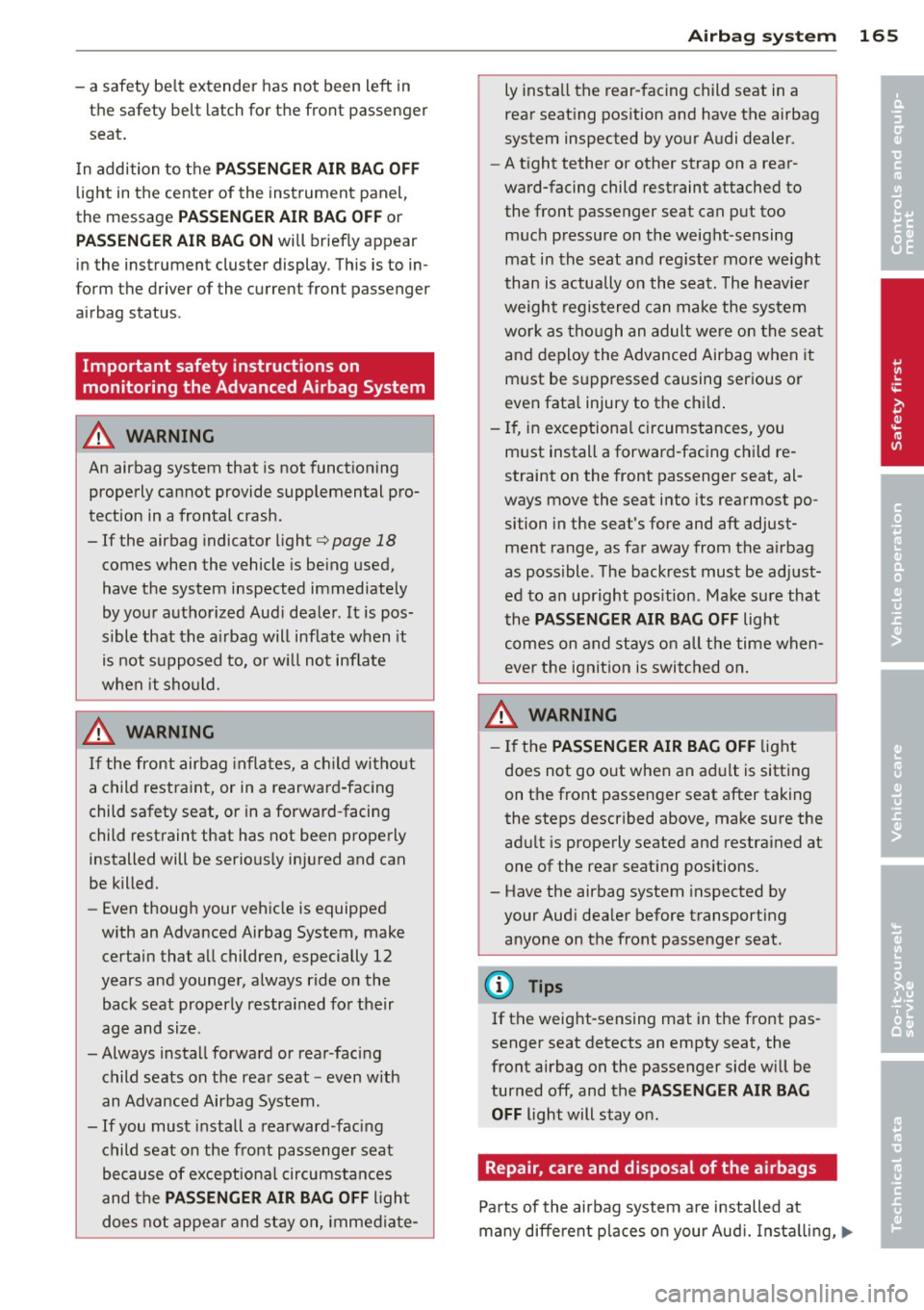
-a safety be lt extender has not been left in
the safety belt latch for the front passenger
seat .
I n addition to the
P ASS ENGER AIR B AG OFF
light in the center of the instrument panel,
the message
PA SSENGE R AIR BAG OFF or
PASSENGER AI R BAG ON will briefly appear
in the instrument cluster display . Th is is to in
form the driver of the current front passenger
airbag status .
Important safety instructions on
monitoring the Advanced Airbag System
A WARNING
An airbag system that is not functioning
properly cannot provide supplemental pro
tection in a frontal crash.
- If the airbag indicator light
c:> page 18
comes when the vehicle is be ing used,
have the system inspected immediately
by your authorized Aud i deale r. It is pos
sible that the a irbag will inf late when it
is not supposed to, or w ill not inflate
when it sho uld.
A WARNING
If the front airbag inflates, a ch ild without
a child restraint, or in a rearward-facing
child safety seat, or in a forward-facing
child restraint that has not been properly
installed will be serio usly injured and can
be killed.
- Even though your vehicle is equipped
with an Advanced Airbag System, make certain that all children, especially 12
years and younger, always ride on the
back seat properly restrained fo r their
age and size .
- Always install forward or rear-facing
child seats on the rea r seat -even w ith
an Advanced Airbag System.
- If you must install a rearward-facing
child seat on the front passenge r seat
because of exceptiona l circumstances
and the
PASSENGER AIR BAG OFF l igh t
does not appea r and s tay on, immediate-
A irbag system 165
ly insta ll the rear-facing child seat in a
rear seat ing pos ition and have the airbag
system inspected by your Audi dealer.
- A tight tether or other strap on a rear
ward-facing child restraint attached to
the front passenger seat can put too
much pressure on the weight-sensing
mat in the seat and reg ister more weight
than is actually on the seat. The heavier
weight registered can make the system
work as tho ugh an adult were on the seat
and deploy the Advanced Airbag when it
m ust be suppressed causing serious or
even fata l injury to the chi ld .
- If, in exceptiona l circumstances, you
m ust install a forward-facing child re
straint on the front passenger seat, al
ways move the seat into its rearmost po sition in the seat's fore and aft adjust
ment range, as fa r away from the a irbag
as poss ible . The backrest must be ad just
ed to an upright pos ition. Make sure that
the
PASSENGER AIR BAG OFF light
comes on and stays on a ll t he time when
ever the ignit ion is switched on .
A WARNING
=
-If the PASSENGER AIR BAG OFF light
does not go out when an ad ult is sitting
on the front passenger seat after taking
the steps described above, make sure the
adu lt is properly seated and restra ined at
one of the rear seat ing pos itions.
- Have the airbag system inspected by
your Aud i dea ler before transporting
anyone on the front passenger seat.
(D Tips
If the weight-sensing mat in the front pas
senger seat detects an empty seat, the
front airbag on the passenger side will be
turned off, and the
PASS ENGER AIR BAG
OFF
light will stay on .
Repair, care and disposal of the airbags
Parts of the airbag system are i nstalled at
many diffe rent p laces o n your Aud i. Insta lling, .,.
•
•
Page 169 of 318
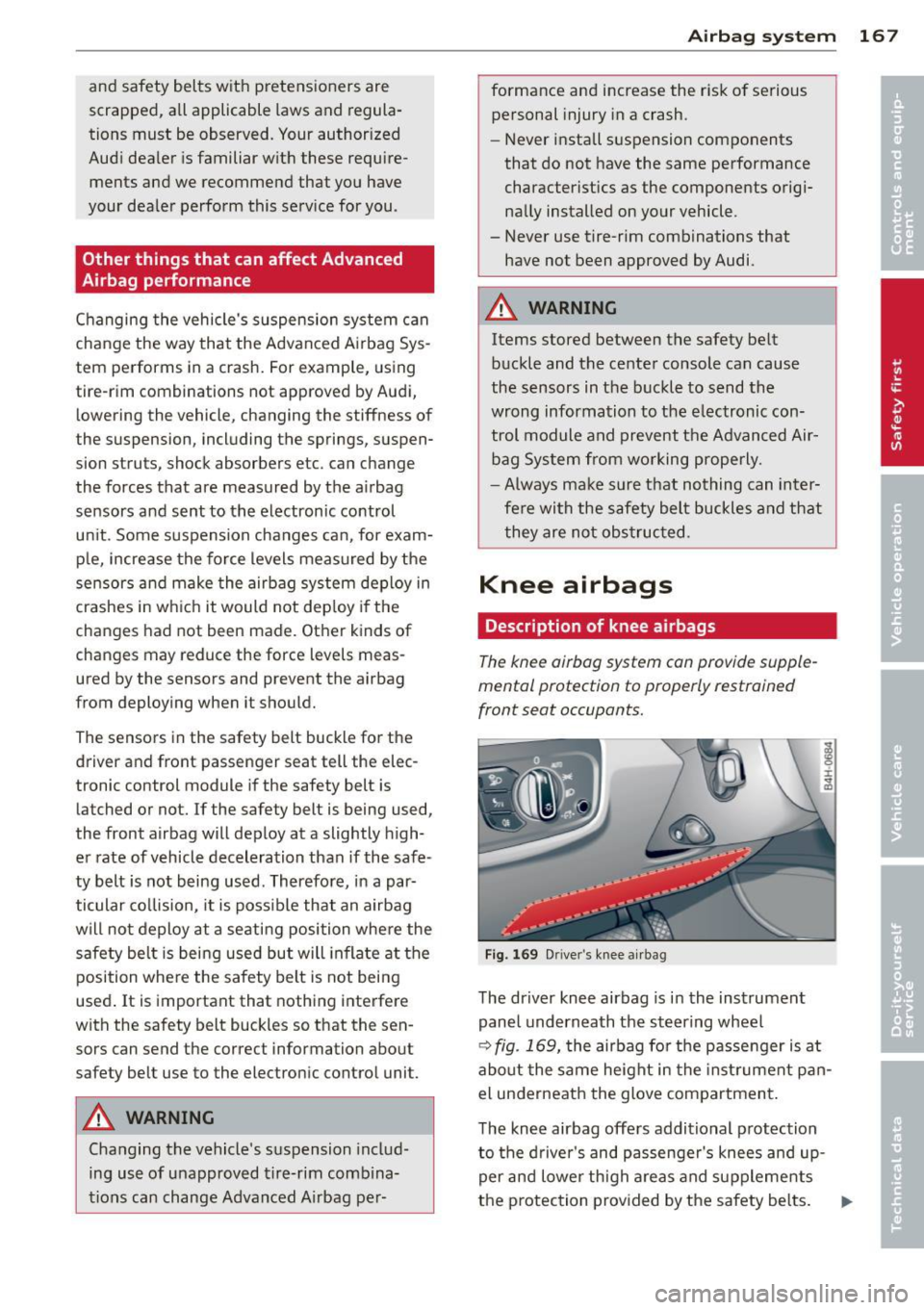
and safety belts with pretensioners are
scrapped, all applicable laws and regula
tions must be observed. Your authorized
Audi dealer is familiar with these require
ments and we recommend that you have
your dealer perform this service for you .
Other things that can affect Advanced
Airbag performance
Changing the vehicle's suspension system can
change the way that the Advanced Airbag Sys
tem performs in a crash. For example, using
tire-rim combinations not approved by Audi,
lowering the vehicle, changing the stiffness of
the suspension, including the springs, suspen
sion struts, shock absorbers etc. can change
the forces that are measured by the airbag
sensors and sent to the electronic control
unit. Some suspension changes can, for exam ple, increase the force levels measured by the
sensors and make the airbag system deploy in
crashes in which it would not deploy if the
changes had not been made. Other kinds of
changes may reduce the force levels meas
ured by the sensors and prevent the airbag
from deploying when it should.
The sensors in the safety belt buckle for the
driver and front passenger seat tell the elec
tronic control module if the safety belt is
latched or not. If the safety belt is being used,
the front airbag will deploy at a slightly high
er rate of vehicle deceleration than if the safe
ty belt is not being used. Therefore, in a par
ticular collision, it is possible that an airbag
will not deploy at a seating position where the safety belt is being used but will inflate at the
position where the safety belt is not being
used . It is important that nothing interfere
with the safety belt buckles so that the sen
sors can send the correct information about
safety belt use to the electronic control unit.
A WARNING
Changing the vehicle's suspension includ
ing use of unapproved tire-rim combina
tions can change Advanced Airbag per-
Airbag system 167
formance and increase the risk of serious
personal injury in a crash.
- Never install suspension components
that do not have the same performance characteristics as the components originally installed on your vehicle.
- Never use tire-rim combinations that have not been approved by Audi.
A WARNING
Items stored between the safety belt buckle and the center console can cause
the sensors in the buckle to send the
wrong information to the e lectronic con
trol module and prevent the Advanced Air
bag System from working properly.
- Always make sure that nothing can inter
fere with the safety belt buckles and that
they are not obstructed.
Knee airbags
Description of knee airbags
The knee airbag system can provide supple
mental protection to properly restrained
front seat occupants.
Fig . 169 Driver 's knee airbag
The driver knee airbag is in the instrument
panel underneath the steering wheel
¢ fig . 169, the airbag for the passenger is at
about the same height in the instrument pan
el underneath the glove compartment.
The knee airbag offers additional protection
to the driver 's and passenger's knees and up
per and lower thigh areas and supplements
the protection provided by the safety belts.
Ill-
Page 171 of 318
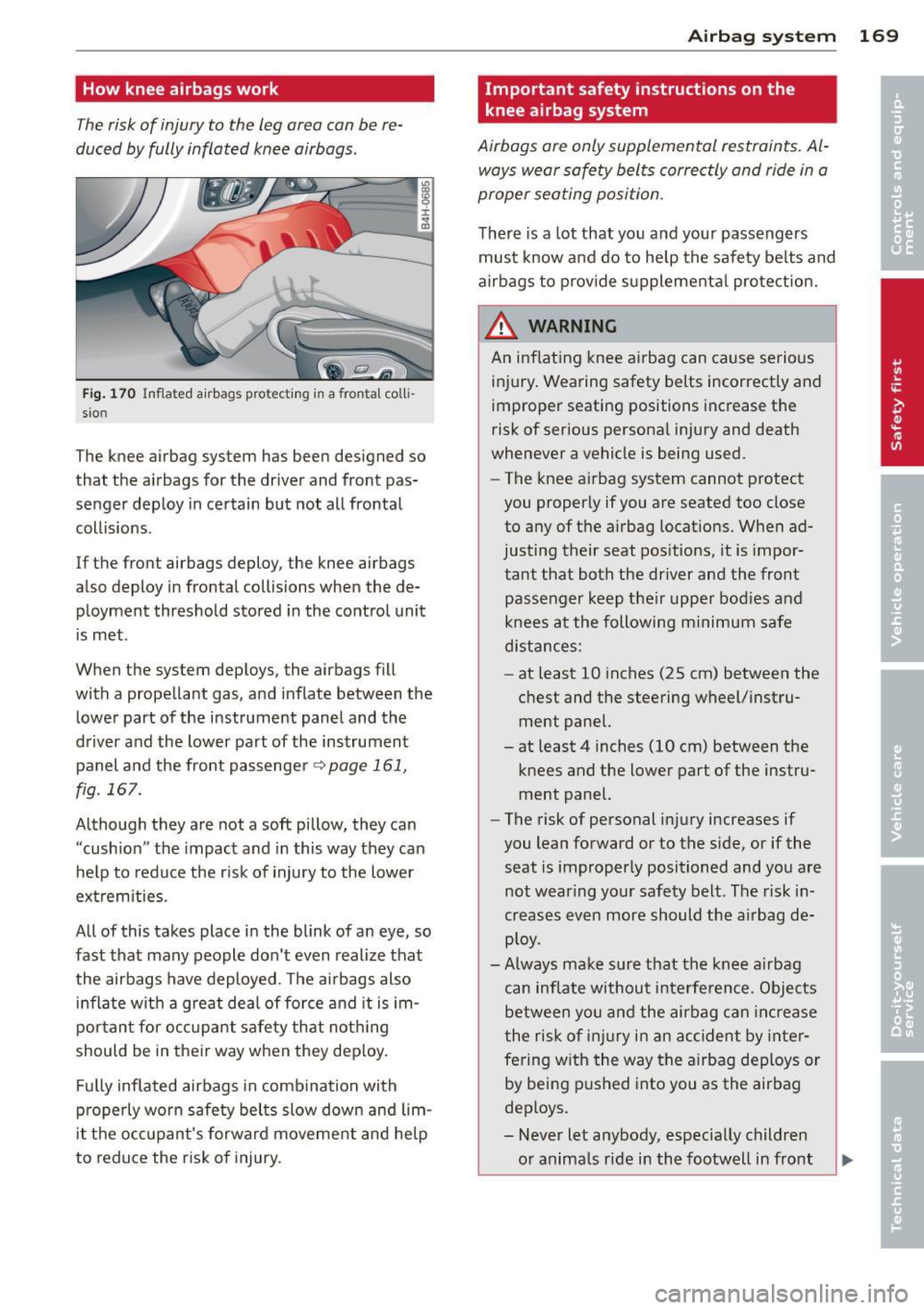
How knee airbags work
The risk of injury to the leg area con be re
duced by fully inflated knee airbags.
Fig. 170 Inflated airbags protecting in a fro ntal coll i
sio n
The knee airbag system has been designed so
that the airbags for the driver and front pas
senger deploy in certain but not all frontal
collisions .
If the front airbags deploy, the knee airbags
also deploy in frontal collisions when the de
ployment threshold stored in the control unit
is met .
When the system deploys, the airbags fill
with a propellant gas, and inflate between the
lower part of the instrument panel and the
driver and the lower part of the instrument
panel and the front passenger~
page 161,
fig . 167.
Although they are not a soft pillow, they can
"cush ion" the impact and in this way they can
help to reduce the risk of injury to the lower
extremities.
All of this takes place in the blink of an eye, so
fast that many people don't even realize that
the airbags have deployed . The airbags also
inflate with a great deal of force and it is im
portant for occupant safety that nothing
should be in their way when they deploy.
Fully inflated airbags in combination with
properly worn safety belts slow down and lim
it the occupant's forward movement and help
to reduce the risk of injury.
Airbag system 169
Important safety instructions on the
knee airbag system
Airbags ore only supplemental restraints . Al
ways wear safety belts correctly and ride in a
proper seating position .
There is a lot that you and your passengers
must know and do to help the safety belts and
airbags to provide supplemental protection.
_& WARNING
An inflating knee airbag can cause serious injury. Wearing safety belts incorrectly and
improper seating positions increase the
risk of serious personal injury and death
whenever a vehicle is being used.
- The knee airbag system cannot protect
you properly if you a re seated too close
to any of the airbag locations. When ad
justing their seat positions, it is impor
tant that both the driver and the front
passenger keep their upper bodies and
knees at the following minimum safe
distances:
- at least 10 inches (25 cm) between the
chest and the steering wheel/instru
ment panel.
- at least 4 inches (10 cm) between the
knees and the lower part of the instru
ment panel.
- The risk of personal injury increases if
you lean forward or to the side, or if the
seat is improperly positioned and you are not wearing your safety belt. The risk in
creases even more should the airbag de ploy.
- Always make sure that the knee airbag
can inflate without interference. Objects
between you and the airbag can increase
the risk of injury in an accident by inter
fering with the way the airbag deploys or
by being pushed into you as the airbag
deploys.
- Never let anybody, especially children
or animals ride in the footwell in front
Page 176 of 318

17 4 Airbag system
-The airbag indicator light in the instrument
panel
The airbag sys tem is monitored electro nica lly
to make certa in it is funct ion ing properly a t all
times. Each time you switch on the ignition,
the a irbag system ind icator light wi ll come on
for a few seconds (self diagnost ics).
The side curtain airb ag i s not activated :
-if the ignit ion is switched off,
- in s ide collisions when the acceleration
measured by the sensor is too low ,
- in rear-end collisions,
- in rollovers .
A WARNING
-
-Safety belts and the a irbag system will
only p rov ide protection when occ upants
are in t he p roper sea ting posit ion
c>page 57, General recommendations.
- If the airbag indicato r ligh t¢ page 18
comes whe n the vehicle is be ing used,
have the system inspected immediate ly
by your aut horized Aud i dea ler . It is pos
sible that the airbag will inflate when it is not s upposed to, or w ill not inflate
when it should.
How side curtain airbags work
Side curtain airbags can work tog ether with
sid e airbags to h elp reduc e the risk of head
and upper torso i njurie s for occupants who
are properly res trained.
F ig . 17 4 Illust rat ion of p rin cipl e: In fl ate d side cu rt a in
airba gs on th e left sid e
The side curtain airbags inflate between the
occupant and the windows on the side of the
"' N ;g
:i: .. m
vehicle that is struck in a side collis ion
¢ fig . 174 .
When the system is triggered, the side curta in
airbag is filled w ith prope llant gas and breaks
through a seam above the front and rear side
windows identified by th e AIRBAG label. In or·
der to he lp provide this add itiona l protection,
the side curta in a irbag must inflate within the
blink of an eye at very high speed and with
great force . The side curta in a irbag could in ·
jure you if your seating pos it io n is not proper
o r upright or if items are located in the area
whe re the supplemental side curta in a irbag
infla tes. This applies especially to ch ild ren
¢ page 176.
Although they are not a soft pi llow, side cur·
ta in a irbags can "cushion" the impact and i n
th is way they can help to reduce the risk of in
j u ry to the head and the uppe r part o f the
body.
A fine dust may deve lop w hen the airbag de·
ploys. Th is is qui te no rma l and does not mean
there is a fire in the vehicle .
Important safety instructions on the
side curtain airbag system
Airbags are only supplemental restraints . Al·
ways properly wear safety belts and rid e in a
proper seating position .
The re is a lot that you and your passengers
must know and do to he lp the safety belts and
airbags do th eir job to provide supp lemental
protection .
A WARNING
-Improperly wearing safety belts and im-
p roper seating posit ions increase the risk
of ser ious personal inju ry and death when·
ever a vehicle is being used.
- Never let occupants place any parts of
their bod ies in the area from which the
side curta in a irbags inflate.
- Always make sure that the s ide curtain
airbags can inflate without interference .
Unsui table ac cessories fitted inside the
-